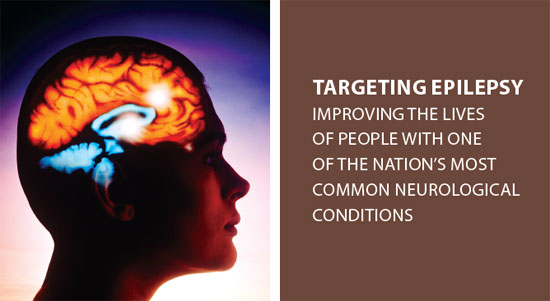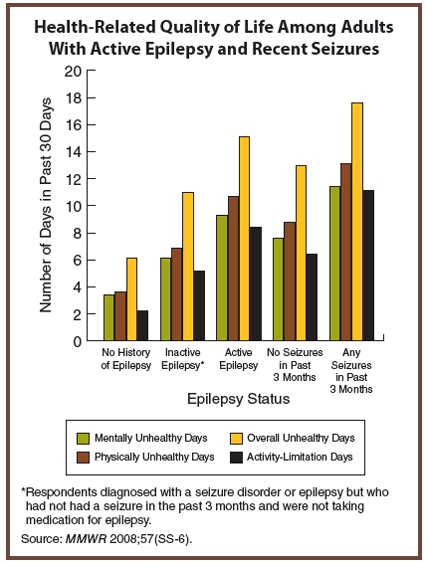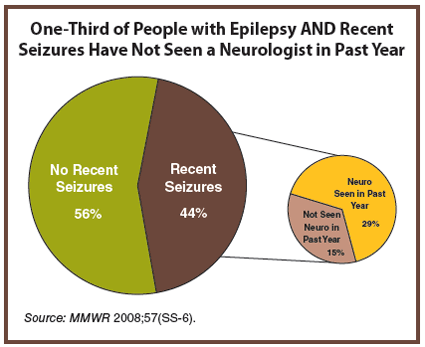 |
|
 |
 |
 |
TARGETING EPILEPSY
Improving the Lives of People with One
of the Nation’s Most Common Neurological Conditions
At A Glance
2009

Epilepsy: Widely Recognized, Poorly Understood
What Is Epilepsy?
Epilepsy is a chronic neurological condition characterized by recurrent
seizures. A seizure happens when abnormal electrical activity in the brain
causes an involuntary change in body movement or function, sensation,
awareness, or behavior. Seizures can vary from a momentary disruption of the
senses, to short periods of unconsciousness or staring spells, to
convulsions. Some people have only one type of seizure. Others have more
than one type. The term epilepsy can be used interchangeably with the
term seizure disorder. Epilepsy is a chronic condition and cannot be
transmitted from person to person.
What Causes Epilepsy?
Epilepsy can be caused by many different conditions that affect a
person’s brain. Examples of these conditions include stroke, head trauma,
complications during childbirth, infections (such as meningitis,
encephalitis, cysticercosis, or brain abscess), and certain genetic
disorders. Often, no definite cause can be found.
Why Is Epilepsy a Public Health Problem?
Epilepsy affects an estimated 2.5 million people in the United States and
each year accounts for $15.5 billion in direct costs (medical) and indirect
costs (lost or reduced earnings and productivity). More than one-third of
people with epilepsy continue to have seizures despite treatment. Each year,
about 200,000 new cases of epilepsy are diagnosed in the United States.
Children younger than 2 years of age and adults older than 65 are most
likely to be affected. In addition, people of low socioeconomic status,
those who live in urban areas, and members of some minority populations are
at increased risk for epilepsy.
Delayed recognition of seizures and inadequate treatment, which may
result from lack of specialty care, greatly increases a person’s risk for
subsequent seizures, brain damage, disability, and death from injuries
incurred during a seizure. Epilepsy is a widely recognized health condition,
but one that is poorly understood by the public, even among people who know
someone with the disorder. Lack of knowledge about the causes of epilepsy
has been associated with negative attitudes, beliefs, and stigma. Lack of
understanding about epilepsy is a leading cause of discrimination in the
workplace and in schools.
What Can Be Done to Improve the Lives of People With Epilepsy?
In 2003, the second National Conference on Public Health and Epilepsy,
Living Well With Epilepsy II, brought together experts in the field, as well
as people with epilepsy and their families. Participants discussed the need
for early recognition, diagnosis, and treatment of epilepsy; advances in
epidemiology and surveillance; better self-management; and improved quality
of life.
Conference participants also called for
- Better access to specialty care and comprehensive systems of care,
as well as improved early detection and treatment of seizures.
- Established criteria to determine quality of care in epilepsy.
- Better understanding of the diagnosis and treatment of the
consequences of epilepsy, especially in the areas of mental health and
cognition.
- Systems and models of care that foster empowerment and independence
for people with epilepsy and support their efforts toward improved
seizure control and a good quality of life.
- Methods and systems to monitor trends related to critical issues,
such as disease burden, mortality risks, and incidence and prevalence in
diverse populations.
- Research and communication approaches to combat the stigma
associated with epilepsy, which will improve community awareness and the
quality of life and care of people with epilepsy.
- Public education to improve people’s ability to recognize seizures
and give first aid.
CDC's National Leadership
During the past 14 years, CDC’s Epilepsy Program has steadily increased
its ability to effectively address public health issues related to epilepsy.
The program works to protect the health of people living with epilepsy,
improve the quality of life of people living with this condition, and
decrease the stigma associated with the disorder. To achieve these goals,
the program has established national and local partnerships to increase
public awareness and deliver targeted educational messages. The Epilepsy
Program supports activities in several key areas, including communication
and education, research, and self-management.
Communication and Education
CDC has a long-standing partnership with the national Epilepsy Foundation
to conduct multifaceted public education and awareness campaigns. These
campaigns are designed to increase awareness about and acceptance of people
with epilepsy and to counteract the social stigma associated with this
disorder through education and community programs.
Past campaigns have focused on underserved population groups, including
African Americans, women, and young people. The 2007–2008 campaign expanded
its focus on African American and Hispanic communities. Campaign activities
included
- Providing Epilepsy Foundation affiliates with tools and resources
(grants, outreach strategies) to reach local African American
communities.
- Developing a new Spanish Web site and a culturally based training
curriculum for community health workers.
In 2000, CDC developed the tool kit “No Label Required” for teenagers
with epilepsy to help them make informed decisions about issues of greatest
concern in their lives. Building on the success of this tool kit, CDC worked
with the Epilepsy Foundation to develop and test an award-winning tool kit
for parents, “You Are Not Alone: Toolkit for Parents of Teens with
Epilepsy.” Tool kit components are designed to empower and support parents
while encouraging their teenagers toward self-management and are available
at http://www.cdc.gov/epilepsy. Both tool kits have been distributed in
traditional and nontraditional ways, including at summer camps and schools,
on Web sites, as part of educational campaigns, and through Epilepsy
Foundation affiliates.
Epidemiological and Prevention Research
CDC is supporting epidemiological studies to define the incidence and
prevalence of epilepsy in different racial and ethnic populations in the
United States. These studies also are being used to identify (1) risk
factors and the severity of epilepsy in minority communities, (2) health
disparities and contributing factors among people with epilepsy, and (3)
process and outcome measures that may be used to define optimum care for
epilepsy.
Since 1998, some state health departments have used Behavioral Risk
Factor Surveillance System (BRFSS) surveys to estimate self-reported
epilepsy prevalence and study relationships between associated behavioral
risk factors, chronic disease comorbidity, and health-related quality of
life. Nineteen states have collected data on the prevalence of epilepsy in
adults reporting a history of epilepsy, and of those, 13 states have
collected more detailed information about current treatment for epilepsy,
symptoms of epilepsy, access to care, and impairments in health-related
quality of life (see charts on pages 3 and 4).
CDC is supporting population-based studies of epilepsy incidence and
prevalence and assessing the relationships between demographic variables,
socioeconomic status, health care use, cost, and outcomes in different
population groups in the District of Columbia and in several states.
Research is also being conducted to estimate epilepsy prevalence and
treatment patterns in older adults using Medicare claims data.

[A text description of this map is also available.]
Self-Management and Mental Health
Improving the ability of people with epilepsy to better manage the
disorder is a priority for CDC’s Epilepsy Program. In 2008, a
computer-based, theory-driven epilepsy self-management program developed for
adults with epilepsy was found to be an effective management tool. Research
is underway to evaluate home-based interventions for treating depression in
people with epilepsy. Research is also continuing in collaboration with the
Substance Abuse and Mental Health Services Administration to examine the
issue of stigma.
Future Directions
CDC will continue to collaborate with the Epilepsy Foundation to expand
education and awareness programs that target different groups, including
racial and ethnic minorities, students and staff of middle schools and high
schools, parents of teenagers with epilepsy, the unemployed and
underemployed, older adults, and police and emergency responders. In
addition, strategies will be developed and implemented to address the needs
of veterans who have endured traumatic brain injuries resulting in epilepsy.
CDC’s Epilepsy Program will continue to use state surveillance data to
expand its study of the prevalence of self-reported epilepsy in selected
state populations. The program also will continue intramural and extramural
research activities to better understand the epidemiology of epilepsy.

[A text description of this map is also available.]
Some of this research will focus on higher-risk
subpopulations, specifically older adults and children. The incidence of
epilepsy and seizures and their co-occurrence with other conditions in
nursing home residents will be studied, as well as the prevalence of
developmental and other disabilities among children with epilepsy in rural
populations. In addition, analysis of epilepsy-related data from the 2003
and 2005 California Health Interview Survey will be expanded to
-
Obtain population-based estimates of the prevalence of
epilepsy and burden of impaired quality of life in persons with epilepsy
by race, ethnicity, and seizure frequency.
-
Gather epilepsy-related data in racial and ethnic
populations.
-
Identify levels of psychological distress, health
disparities, and unmet mental health needs in adults with epilepsy.
Back to top
Related Materials
Back to top
|
For more information please contact
Centers for Disease Control and Prevention
National Center for Chronic Disease Prevention and Health Promotion
4770 Buford Highway NE, Mail Stop K–51, Atlanta, GA 30341-3717
Telephone: 770-488-5464 • Web:
http://www.cdc.gov/epilepsy
|
|
 One or more documents on this Web page is available in Portable Document Format
(PDF). You will need Acrobat
Reader (a free application) to view and print these documents.
One or more documents on this Web page is available in Portable Document Format
(PDF). You will need Acrobat
Reader (a free application) to view and print these documents.
Page last reviewed: January 29, 2009
Page last modified: January 29, 2009
Content source: National Center for
Chronic Disease Prevention and Health Promotion |
 |
![]() One or more documents on this Web page is available in Portable Document Format
(PDF). You will need Acrobat
Reader (a free application) to view and print these documents.
One or more documents on this Web page is available in Portable Document Format
(PDF). You will need Acrobat
Reader (a free application) to view and print these documents.